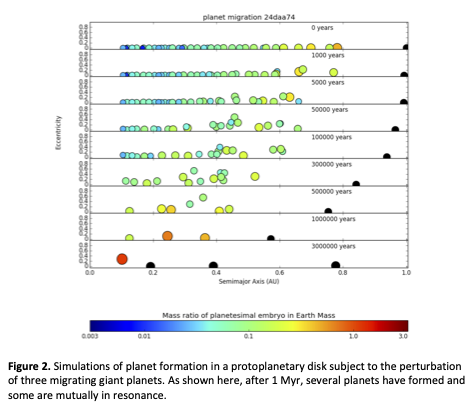Size and resonance diversity of multi-planet resonant chains is a natural outcome of their formation
- 1University of Hawaii, Institute for Astronomy, Honolulu, HI, United States of America (nader@ifa.hawaii.edu)
- 2Planetary Science Institute, Honolulu, HI, United States of America
The discovery of multi-planet resonant chains such as those in TRAPPIST-1 and Kepler-90, where adjacent planets are in different commensurabilities, has raised questions on the formation of these systems and the reason for the diversity of their resonances. It is widely accepted that these systems formed through the combination of migration and resonance-capture where migrating planets capture each other in resonances. However, this scenario cannot explain why adjacent planets have different period-ratios. The reason is that migrating planets tend to capture each other in the same resonances (e.g., the three giant planets in the four-planet system of GJ 876 are in a 4:2:1 Laplace resonance).
To overcome this difficulty, it has been suggested that the diversity of resonances in resonant-chain systems is a post-capture phenomenon that has roots in the mutual tidal interactions of these bodies. That is, after planets have been captured in the same resonance, tidal forces cause the planets to leave their commensurabilities until they are captured in a different resonance. The latter motivated us to examine the validity of this scenario, both during the formation of resonant chains and also as a post-formation phenomenon.
To determined the probability of forming resonant chains and capture in different resonances, we carried out more than 2700 simulations of multiple-planet migration, where fully formed planets were migrating while interacting with one another, and more than 60 simulations of planet formation in a protoplanetary disk subject to the perturbation of migrating planets. Simulations were carried out for different values of planets’ masses and migration rates, and the number of migrating planets.
Figure 1 shows the results. As shown here, from all our simulations, only 130 (~5%) resulted in captures into resonances suggesting that multi-planet resonances are not a common occurrence. The largest number of captures appears for 5:3 (a new finding) followed by 3:2 and 2:1 resonances. Results also showed that the probability of capture (and, therefore, the final commensurabilities) is highly depended on the characteristics of the systems, especially the planets’ mass-ratio and migration speed. Figure 2 shows a sample of our planet formation simulations in which planets form in a protoplanetary disk that is subject to the perturbation of three migrating giant planets. As shown here, after 1 Myr, super-Earth and larger planet are formed with some being mutually captured in resonances (i.e., forming a resonant chain).
Our simulations also demonstrated that capture in a resonance never occurs at the resonance’s exact commensurability and there is always some deviation (Figure 3). The extent of this deviation also depends on the mass-ratio and orbital characteristics of the planets and the mechanism through which migrating planets lose energy.
Collectively, our results confirm that, 1) migrating planets can be captured in different resonances and that the diversity of resonances observed in resonant chains is a natural consequence of the formation and resonance capture mechanism, and does not require a secondary, post-formation process, and 2) no post-capture mechanism is needed to explain the deviation from exact commensurabilities observed in Kepler (and RV) planet pairs.

How to cite: Haghighipour, N.: Size and resonance diversity of multi-planet resonant chains is a natural outcome of their formation, Europlanet Science Congress 2022, Granada, Spain, 18–23 Sep 2022, EPSC2022-303, https://doi.org/10.5194/epsc2022-303, 2022.

